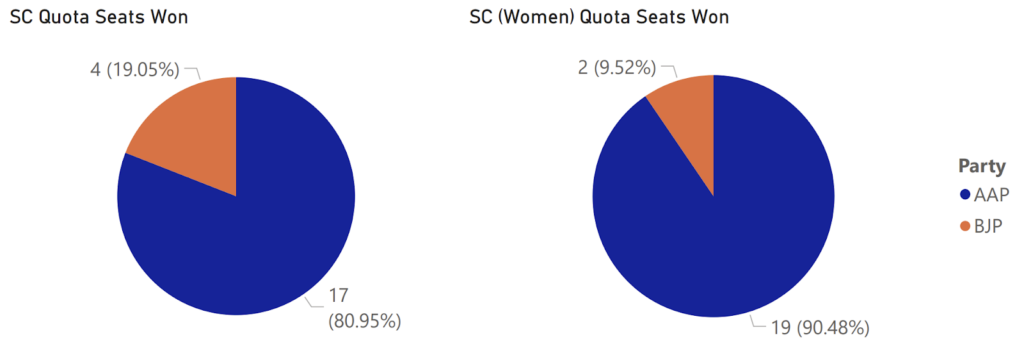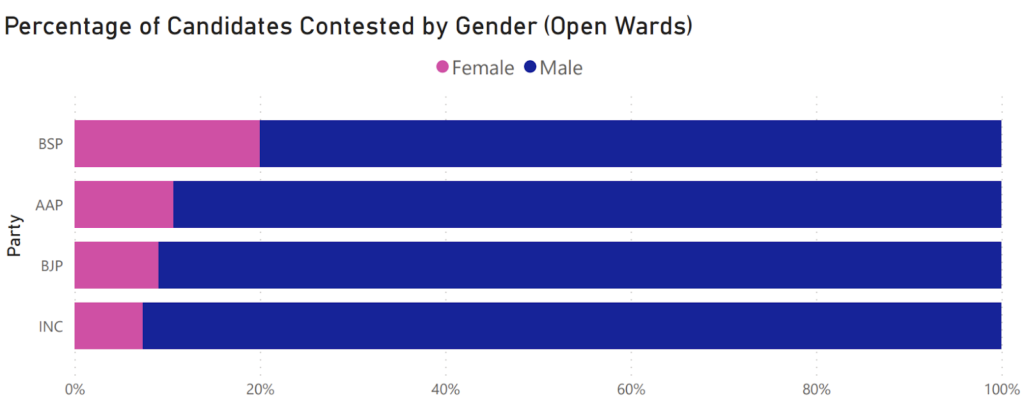Introduction
The 2022 Delhi Municipal Corporation elections marked a significant turning point in the political landscape of the city. The incumbent Bharatiya Janata Party (BJP) lost ground to the Aam Aadmi Party (AAP), as the latter saw an unprecedented increase in their seat share, rising from 18% in the 2017 elections to a commanding 54% in 2022. Meanwhile, the BJP’s seat share fell from 67% in 2017 to 42% in 2022. Despite the BJP’s slight lead in the 104 unreserved wards, the AAP ultimately emerged victorious, securing a commanding advantage of 30 seats through a preponderance of wins in the reserved wards. This article provides a deeper dive into the 2022 Delhi Municipal Elections.
A Breakdown of the Numbers
The 2022 Delhi Municipal Elections saw 15 different parties vying for power across 250 wards. The AAP and BJP were the biggest players, contesting all 250 wards, while the Indian National Congress (INC) and Bahujan Samaj Party (BSP) contested 247 and 132 wards respectively. Of the 250 wards, 146 (58.4%) were reserved. As seen in Figure 1, in the 104 open wards, the BJP came out on top with 51 seats, followed closely by AAP with 48 seats while the Congress secured just 4 seats. However, in the 104 women quota wards, AAP had a slight edge with 50 seats compared to the BJP’s 47 seats. Here too, it is observed that INC’s performance was dismal with the party securing just 5 seats.

Figure 1. Seats won by parties in Open and Women’s Quota
Women’s Representation: Progress and Challenges
AAP also dominated in the Scheduled Caste and Scheduled Caste – Women category wards, winning over 80% of seats in the former and 90% in the latter. Unfortunately, the INC didn’t fare as well and failed to secure any seats in the 20 SC and 21 SC-Women reservation wards that it contested.

Figure 2. Seats won by parties in SC and SC-Women Quota
Among the 629 candidates vying for office in 104 open wards, only 82 were women, constituting a meager 13% of the total pool. Similarly, in the SC category wards, out of the 111 contesting candidates, a mere 18 were women, accounting for 16.2% of the total.
However, there is reason to be optimistic. The BSP fielded the most women candidates compared to all other parties, both in absolute magnitude and in proportion to their total number of contestants, in both the open and SC category wards. In open wards, the BSP fielded 20% of women candidates compared to AAP’s 10%, BJP’s 9%, and the INC at a measly 7.4%. In SC wards, again, the BSP fielded 19% women, against 12%, 9%, and 4.7% from the AAP, BJP, and INC respectively. With 14 women candidates in total, the BSP surpassed its competitors in terms of promoting gender diversity in politics. While these figures indicate that there is still progress to be made, the BSP’s focus on women candidates is encouraging and points to changes in party politics and structures with more equitable representation in the electoral process.


Figure 3. Gender Ratio of Candidates across parties
While it is certainly disappointing to learn that despite efforts to promote gender diversity, only 13 women (10.4%) were elected in the combined 125 open and SC category wards in the recent elections – there is some good news – the representation of women in the Municipal Corporation of Delhi committee now stands at 138 (55.2%) after the 2022 elections.
Education as a factor
There were interesting insights with respect to the candidates’ educational backgrounds as well. As seen in figure 4, the AAP fielded a high proportion of candidates with a graduate degree (34.4%) and fewer candidates with postgraduate degrees (9.2%). The BJP, on the other hand, had a higher proportion of candidates with postgraduate degrees (15.6%) but fewer with graduate degrees (26.4%). The INC had a similar proportion of graduate and post-graduate candidates, with a slightly higher proportion of candidates with a high school education. The BSP had the lowest proportion of candidates with higher education degrees, but a higher proportion of candidates with a high school education or less.

Figure 4. Educational Background of Candidates across Parties
The educational qualifications of candidates can significantly affect the election outcome. The AAP’s higher proportion of candidates with graduate degrees may have given them an advantage, while the BSP’s lower proportion of candidates with higher education may have hurt their performance.
Conclusion
The 2022 Delhi Municipal Elections held many important changes that impacted the outcome of the election – the most notable being the delimitation which brought about a decrease in the number of wards from 272 to 250, and the combination of the North, East, and South municipal corporations into a single one. This rendered any one-to-one comparison at the ward level between the 2017 and 2022 elections difficult. On a broader level, unlike the previous election, only three political parties and some independents won seats in the 2022 election. Back in 2017, the BJP had a big win, while the remaining seats were split among five other political parties and some independent candidates. The 2022 Delhi Municipal Elections brought about a significant change in the political landscape of the city, with the AAP emerging as the dominant player. In 2022, despite a higher number of women candidates, barely a tenth were proportionally elected in the combined open and SC category wards. The data highlights the importance of candidate demographics in shaping the election outcome. Women and candidates with higher education degrees were underrepresented, but there were some positive developments, such as the BSP fielding the most women candidates, and an increase in women’s representation in the Municipal Corporation of Delhi committee. Overall, the 2022 Delhi Municipal Elections demonstrated the importance of diverse representation in politics and the need for continued efforts to promote equity and inclusion in the electoral process.
References:
Data Citation: “TCPD-CASI Urban Local Body Dataset (TCPD-CASI-ULB), 2008-2021”. Trivedi Centre for Political Data, Ashoka University, and Center for the Advanced Study of India, University of Pennsylvania.
Codebook Citation: Neelesh Agrawal, Adam Auerbach, Mohammed Zahir Ali, Srishti Gupta, Mohit Kumar, Aditya Sarkar, Tariq Thachil, Gilles Verniers, and S. V. Sai Vikas. 2022. “TCPD-CASI Urban Local Body Dataset (TCPD-CASI-ULB), 2008-2021 Codebook 1.0″, Trivedi Centre for Political Data, Ashoka University, Center for the Advanced Study of India, University of Pennsylvania.
Acknowledgments:
I would like to extend my thanks to Srishti Gupta and the entire TCPD team for their guidance and support throughout.
About:
Zahir is a fourth-year Ashoka Scholar’s Programme (ASP) student at Ashoka University and a Research Associate at TCPD, having worked on the Urban Local Bodies dataset project since its inception. Throughout his interdisciplinary academic journey, he has dabbled in Psychology, Computer Science, and Economics. He is particularly interested in working with Political and Economic data.
Disclaimer
This article belongs to the author(s) and is independent of the views of the Centre.

